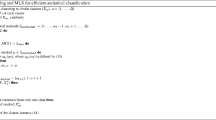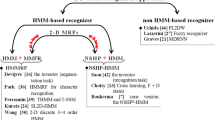Abstract
A new scheme for the optimization of codebook sizes for Hidden Markov Models (HMMs) and the generation of HMM ensembles is proposed in this paper. In a discrete HMM, the vector quantization procedure and the generated codebook are associated with performance degradation. By using a selected clustering validity index, we show that the optimization of HMM codebook size can be selected without training HMM classifiers. Moreover, the proposed scheme yields multiple optimized HMM classifiers, and each individual HMM is based on a different codebook size. By using these to construct an ensemble of HMM classifiers, this scheme can compensate for the degradation of a discrete HMM.









Similar content being viewed by others
References
Altincay H (2005) A Dempster-Shafer theoretic framework for boosting based ensemble design. Pattern Anal Appl J 8(3):287–302
Arica N, Vural FTY (2000) A shape descriptor based on circular Hidden Markov Model. In: 15th International conference on pattern recognition (ICPR00)
Bandyopadhyay S, Maulik U (2001) Non-parametric genetic clustering: comparison of validity indices. IEEE Trans Syst Man Cybern Part-C 31(1):120–125
Bengio Y (1999) Markovian models for sequential data. Neural Comput Surv 2:129–162
Britto A Jr. (2001) A two-stage HMM-based method for recognizing handwritten numeral strings. Ph.D. Thesis, Pontifical Catholic University of Paraná
Britto AS, Sabourin R, Bortolozzi F, Suen CY (2003) Recognition of handwritten numeral strings using a two-stage Hmm-based method. Int J Doc Anal Recognit 5(2–3):102–117
Brown G, Wyatt J, Harris R, Yao X (2005) Diversity creation methods: a survey and categorisation. Int J Inf Fusion 6(1):5–20
Conversano C (2002) Bagged mixtures of classifiers using model scoring criteria. Pattern Anal Appl 5(4):351–362
Davis RIA, Lovell BC (2004) Comparing and evaluating HMM ensemble training algorithms using train and test and condition number criteria. Pattern Anal Appl 6(4):327–335
Dietterich TG (2002) Machine learning for sequential data: a review. In: Structural, Structural, syntactic, and statistical pattern recognition, Lecture Notes in Computer Science, vol 2396. Springer, Heidelberg, , pp 15–30
Eppstein D (1998) Fast hierarchical clustering and other applications of dynamic closest pairs. In: Proceedings of the ninth ACM-SIAM symposium on discrete algorithms, pp 619–628
Grove A, Schuurmans D (1998) Boosting in the limit: maximizing the margin of learned ensembles. In: Proceedings of the fifteenth national conference on artificial intelligence, pp 692–699
Guenter S, Bunke H (2005) Off-line cursive handwriting recognition using multiple classifier systems—on the influence of vocabulary, ensemble, and training set size. Opt Lasers Eng 43:437–454
Guenter S, Bunke H (2004) Ensembles of classifiers derived from multiple prototypes and their application to handwriting recognition. International workshop on multiple classifier systems (MCS 2004), pp 314–323
Guenter S, Bunke H (2003) Off-line cursive handwriting recognition—on the influence of training set and vocabulary size in multiple classifier systems. In: Proceedings of the 11th conference of the international graphonomics society
Guenter S, Bunke H (2002) A new combination scheme for HMM-based classifiers and its application to handwriting recognition. In: Proceedings of 16th international conference on pattern recognition II, pp 332–337
Guenter S, Bunke H (2002) Generating classifier ensembles from multiple prototypes and its application to handwriting recognition. In: Proceedings of the 3rd international workshop on multiple classifier systems, pp 179–188
Guenter S, Bunke H (2002) Creation of classifier ensembles for handwritten word recognition using feature selection algorithms. In: Proceedings of the 8th international workshop on frontiers in handwriting recognition, pp 183–188
Guenter S, Bunke H (2003) Ensembles of classifiers for handwritten word recognition. Int J Doc Anal Recognit 5(4):224–232
Guenter S, Bunke H (2003) New boosting algorithms for classification problems with large number of classes applied to a handwritten word recognition task. In: Proceedings of the 4th international workshop on multiple classifier systems, pp 326–335
Guenter S, Bunke H (2003) Fast feature selection in an HMM-based multiple classifier system for handwriting recognition. Pattern recognition, proceedings of the 25th DAGM symposium, pp 289–296
Guenter S, Bunke H (2004) Optimization of weights in a multiple classifier handwritten word recognition system using a genetic algorithm. Electron Lett Comput Vis Image Anal 3(1):25–44
Halkidi M, Batistakis Y, Vazirgiannis M (2001) On clustering validation techniques. J Intell Inf Syst 17(2–3)
Halkidi M, Batistakis Y, Vazirgiannis M (2002) Clustering validity checking methods: part II. SIGMOD Rec 31(3):19–27
Ho TK (1998) The random space method for constructing decision forests. IEEE Trans Pattern Anal Mach Intell 20(8):832–844
Huang X, Acero A, Hon H (2001) Spoken language processing—a guide to theory, algorithm, and system development. Prentice-Hall, Englewood Cliffs
Johnson E, Kargupta H (1999) Collective, hierarchical clustering from distributed, heterogeneous data. In: Large-scale parallel KDD systems, pp 221–244
Kittler J, Hatef M, Duin RPW, Matas J (1998) On combining classifiers. IEEE Trans Pattern Anal Mach Intell 20(3):226–239
Ko A, Sabourin R, Britto A Jr. (2006) Combining diversity and classification accuracy for ensemble selection in random subspaces. In: IEEE world congress on computational intelligence (WCCI 2006)—international joint conference on neural networks (IJCNN 2006)
Ko A, Sabourin R, Britto A Jr. (2006) Evolving ensemble of classifiers in random subspace. Genetic and evolutionary computation conference (GECCO 2006)
Kuncheva LI (2002) A theoretical study on six classifier fusion strategies. IEEE Trans Pattern Anal Mach Intell 24(2):281–286
Kuncheva LI, Skurichina M, Duin RPW (2002) An experimental study on diversity for bagging and boosting with linear classifiers. Int J Inf Fusion 3(2):245–258
Masulli F, Valentini G (2004) Effectiveness of error correcting output coding methods in ensemble and monolithic learning machines. Pattern Anal Appl 6(4):285–300
Maulik U, Bandyopadhyay S (2002) Performance evaluation of some clustering algorithms and validity indices. IEEE Trans Pattern Anal Mach Intell 24(12):1650–1654
Milgram J, Cheriet M, Sabourin R (2005) Estimating accurate multi-class probabilities with support vector machines. International joint conference on neural networks (IJCNN 05), pp 1906–1911
Oliveira LS, Sabourin R, Bortolozzi F, Suen CY (2002) Automatic recognition of handwritten numerical strings: a recognition and verification strategy. IEEE Trans Pattern Anal Mach Intell 24(11):1438–1454
Pakhira MK, Bandyopadhyay S, Maulik U (2004) Validity index for crisp and fuzzy clusters. Pattern Recognit 37(3):487–501
Pekalska E, Skurichina M, Duin RPW (2004) Combining dissimilarity-based one-class classifiers. international workshop on multiple classifier systems (MCS 2004), pp 122–133
Rabiner LR (1989) A tutorial on hidden markov models and selected applications in speech recognition. Proc IEEE 77(2):257–286
Rabiner LR, Juang BH (1993) Fundamentals of speech recognition. Prentice-Hall, Engelwood Cliffs
Ruta D, Gabrys B (2005) Classifier selection for majority voting. Int J Inf Fusion, pp 63–81
Schapire RE, Freund Y, Bartlett P, Lee WS (1998) Boosting the margin: a new explanation for the effectiveness of voting methods. Ann Stat 26(5):1651–1686
Seo J, Shneiderman B (2002) Interactively exploring hierarchical clustering results. IEEE Comput 35(7):80–86
Shipp CA, Kuncheva LI (2002) Relationships between combination methods and measures of diversity in combining classifiers. Int J Inf Fusion 3(2):135–148
Smyth P, Heckerman D, Jordan MI (1997) Probabilistic independence networks for hidden Markov probability models. Neural Comput 9:227–269
Wang X (1994) Durationally constrained training of HMM without explicit state durational. Proc Inst Phonetic Sci 18:111–130
Wolpert DH, Macready WG (1997) No free lunch theorems for search. In: IEEE transactions on evolutionary computation
Whitley D (2000) Functions as permutations: regarding no free lunch, walsh analysis and summary statistics. Parallel problem solving from nature (PPSN 2000), pp 169–178
Xie XL, Beni G (1991) A validity measure for fuzzy clustering. IEEE transactions of pattern analysis and machine intellegence, pp 841–847
Xu L, Krzyzak A, Suen CY (1992) Methods of combining multiple classifiers and their applications to handwriting recognition. IEEE Trans Syst Man Cybern 22(3):418–435
Xu L, Krzyzak A, Suen CY (1992) Methods of combining multiple classifiers and their applications to handwriting recognition. IEEE Trans Syst Man Cybern 22(3):418–435
Zouari H, Heutte L, Lecourtier Y, Alimi A (2004) Building diverse classifier outputs to evaluate the behavior of combination methods: the case of two classifiers. International workshop on multiple classifier systems (MCS 2004), pp 273–282
Acknowledgment
This work was supported in part by grant OGP0106456 to Robert Sabourin from the NSERC of Canada.
Author information
Authors and Affiliations
Corresponding author
Rights and permissions
About this article
Cite this article
Ko, A.HR., Sabourin, R. & Britto, A.d. Ensemble of HMM classifiers based on the clustering validity index for a handwritten numeral recognizer. Pattern Anal Applic 12, 21–35 (2009). https://doi.org/10.1007/s10044-007-0094-6
Received:
Accepted:
Published:
Issue Date:
DOI: https://doi.org/10.1007/s10044-007-0094-6




